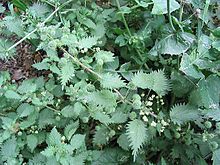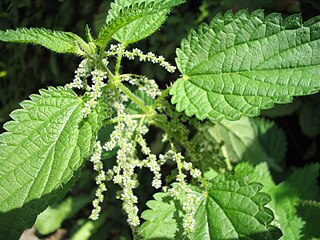
The Urticaceae are a family, the nettle family, of flowering plants. The family name comes from the genus Urtica. The Urticaceae include a number of well-known and useful plants, including nettles in the genus Urtica, ramie, māmaki, and ajlai.

Urtica dioica, often known as common nettle, burn nettle, stinging nettle or nettle leaf, or just a nettle or stinger, is a herbaceous perennial flowering plant in the family Urticaceae. Originally native to Europe, much of temperate Asia and western North Africa, it is now found worldwide. The species is divided into six subspecies, five of which have many hollow stinging hairs called trichomes on the leaves and stems, which act like hypodermic needles, injecting histamine and other chemicals that produce a stinging sensation upon contact.

Urtica is a genus of flowering plants in the family Urticaceae. Many species have stinging hairs and may be called nettles or stinging nettles. The generic name Urtica derives from the Latin for 'sting'.
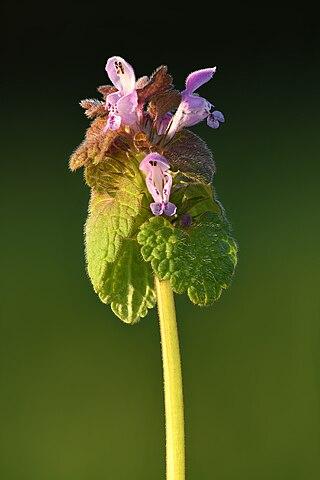
Lamium purpureum, known as red dead-nettle, purple dead-nettle, or purple archangel, is an annual herbaceous flowering plant native to Europe and Asia.
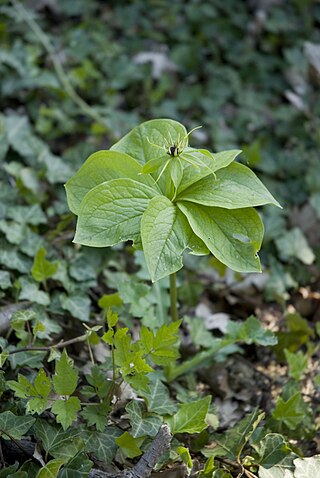
Paris quadrifolia, the herb Paris or true lover's knot, is a species of flowering plant in the family Melanthiaceae. It occurs in temperate and cool areas throughout Eurasia, from Spain to Yakutia, and from Iceland to Mongolia. It prefers calcareous soils and lives in damp and shady places, especially old established woods and stream banks.
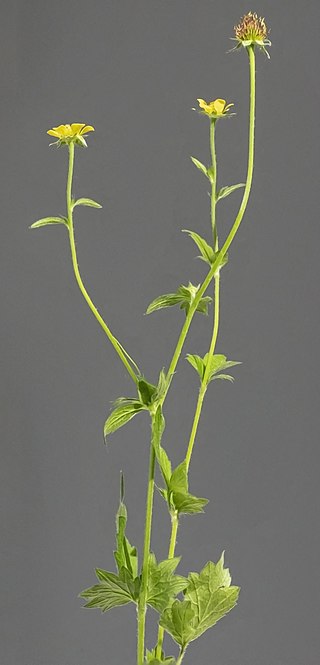
Geum urbanum, also known as wood avens, herb Bennet, colewort and St. Benedict's herb, is a perennial plant in the rose family (Rosaceae), which grows in shady places in the temperate regions of Eurasia and North America.

Peucedanum ostruthium or Imperatoria ostruthium, masterwort, is a species of flowering plant in the family Apiaceae. It is native to the mountains of Central and Southern Europe, but has been widely introduced outside its native range.

Gymnocarpium dryopteris, the western oakfern, common oak fern, oak fern, or northern oak fern, is a deciduous fern of the family Cystopteridaceae. It is widespread across much of North America and Eurasia. It has been found in Canada, the United States, Greenland, China, Japan, Korea, Russia, and most of Europe. It is a seedless, vascular plant that reproduces via spores and have a life cycle with alternating, free-living sporophyte and gametophyte phases.

Urtica ferox, commonly known as tree nettle and, in Māori, ongaonga, taraonga, taraongaonga, оr okaoka, is a species of nettle endemic to New Zealand. Unlike the other species in the genus Urtica found in New Zealand, all of which are herbaceous, ongaonga is a large woody shrub that can grow to a height of 3 m (9.8 ft), with the base of the stem reaching 12 cm (4.7 in) in thickness. It has large spines that can result in a painful sting that lasts several days.
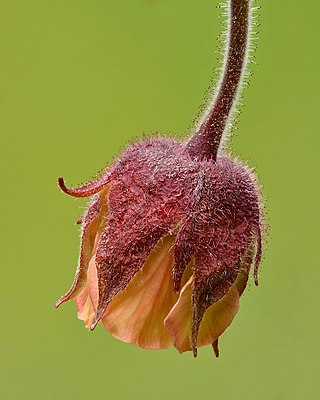
Geum rivale, the water avens, is a flowering plant in the genus Geum within the family Rosaceae. Other names of the plant are nodding avens, drooping avens, cure-all, water flower and Indian chocolate. It is native to the temperate regions of Europe, Central Asia and parts of North America, where it is known as the purple avens. It grows in bogs and damp meadows, and produces nodding red flowers from May to September.

Lamium album, commonly called white nettle or white dead-nettle, is a flowering plant in the family Lamiaceae. It is native throughout Europe and Asia, growing in a variety of habitats from open grassland to woodland, generally on moist, fertile soils.

Lathyrus aphaca, known as the yellow pea or yellow vetchling, is an annual species in the family Fabaceae with yellow flowers and solitary, pea-like fruits. It originated in the Middle East and has spread throughout Europe and beyond as a weed of cultivated fields and roadsides. The fruits are eaten as a supplement to diets in some parts of South Asia but are narcotic and potentially toxic in large quantities.

Allium unifolium, the one-leaf onion or American garlic, is a North American species of wild onion. It is native to the coastal mountain ranges of California, Oregon, and Baja California. It grows on clay soils including serpentine, at elevations up to 1100 m.

Urtica urens, commonly known as annual nettle, dwarf nettle, small nettle, dog nettle, or burning nettle, is a herbaceous annual flowering plant species in the nettle family Urticaceae. It is native to Eurasia, including the Himalayan regions of Kalimpong, Darjeeling and Sikkim in India and can be found in North America, New Zealand and South Africa as an introduced species. It is reputed to sting more strongly than common nettle.

Anthyllis vulneraria, the common kidneyvetch, kidney vetch or woundwort is a medicinal plant native to Europe. The name vulneraria means "wound healer".

Urtica dioica subsp. galeopsifolia, the fen nettle or stingless nettle, is a herbaceous perennial plant found in Europe. It is considered to be either a subspecies of stinging nettle, or a species in its own right: Urtica galeopsifolia.

Carex binervis, the green-ribbed sedge, is a European species of sedge with an Atlantic distribution. It is found from Fennoscandia to the Iberian Peninsula, and occurs in heaths, moorland and other damp, acidic environments. It typically grows to a height of 15–120 cm (6–50 in), and has inflorescences comprising one male and several female spikes, each up to 45 mm (1.8 in) long. The utricles have two conspicuous green veins, which give rise to both the scientific name and the common name of the species. In the vegetative state, it closely resembles C. bigelowii, a species that usually grows at higher altitude. C. binervis was first described by James Edward Smith in 1800, and is classified in Carex sect. Spirostachyae; several hybrids with other Carex species are known.

Carex pilulifera, the pill sedge, is a European species of sedge found in acid heaths, woods and grassland from Macaronesia to Scandinavia. It grows up to 30 cm (12 in) tall, with 2–4 female spikes and 1 male spike in an inflorescence. These stalks bend as the seeds ripen, and the seeds are collected and dispersed by ants of the species Myrmica ruginodis.

Suaeda vera, also known as shrubby sea-blite, shrubby seablight or in the USA sometimes as alkali seepweed, is a species of flowering plant in the family Amaranthaceae. It is a small shrub, with very variable appearance over its wide range. It is a halophyte, and occurs in arid and semi-arid saltflats, salt marshes and similar habitats.

Urtica gracilis, commonly known as the slender nettle, tall nettle, or American stinging nettle, is a perennial plant plant without woody stems that is well known for the unpleasant stinging hairs on its leaves and stems. It is native to much of the North America from Guatemala northwards and temperate areas of South America. It is easily confused with the visually very similar Eurasian species Urtica dioica and is still listed in some resources as a subspecies of this plant. However, genetic analysis and experiments show that they are genetically distinct.
